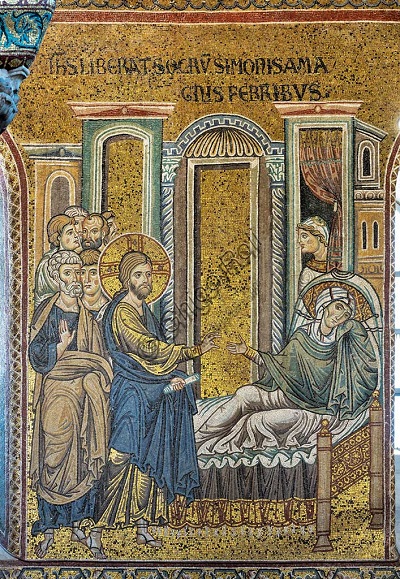Pietro's mother-in-law: from slavery to service
Publish date 31-08-2022
 A short passage, quoted by the three evangelists: Luke, Mark and Matthew, must convey an important message beyond the historical fact. This is what we will try to see.
A short passage, quoted by the three evangelists: Luke, Mark and Matthew, must convey an important message beyond the historical fact. This is what we will try to see.
We are in Capernaum in Galilee where Jesus spent his first years of life and begins his ministry. It is his first day as a Messenger of Love. He took on human nature to fulfill the mission entrusted to him by the Father: to reveal that he loves his children and wants them happy. "Walk on the path that I will prescribe to you so that you may be happy" (Jer 7:23).
On the so-called "Day of Capernaum" the evangelist Mark presents the core of Jesus' activity, anticipates what his mission will be and summarizes the history of salvation: to lead humanity from servitude to idols, enslaving, serving God as his children. This is the message conveyed by the healing of Peter's mother-in-law who "was in bed with a fever". Jesus leaves the Synagogue, a sacred place where he translated the Word and the Law into action of life, healing a man on the Sabbath day and with two disciples enters a place of weekday holiness: the house of Simon and Andrew. It is the first contact with the one who will call Peter. Their mother-in-law lies ill, does not speak, does not ask for anything, it is the others who urge him to take care of her. Jesus bends over the sick woman, with that tenderness and mercy proper to God. He takes her by the hand and makes her stand up. "The fever left her and she served them." For Mark it is the first healing miracle performed by Jesus who says just how He transformed the slavery of fever, which forced the woman to bed, into the freedom of service to the Lord. That diakonia that guided the life of Jesus is entrusted to a woman ... Perhaps she wants to be a model of female diakonia in the Church.
Different is the story of Matthew, much shorter, it focuses on the two figures of the scene: Jesus, the Liberator and the woman prisoner. No mention of the disciples. The woman was in bed with a fever (clear the call to humanity rendered impotent by idols). Jesus sees the situation of suffering and intervenes spontaneously, touches it and the woman is freed from the fever. She is standing, she is risen, we have the same verb used for the resurrection of Christ, precisely to indicate that her liberating touch leads to the resurrection. The healed mother-in-law rushes to serve Jesus by preparing lunch (perhaps the one for the shabat). Like Mark, Matthew also reveals how liberation opens up to service, the same service in which Jesus is engaged: "I am among you as one who serves" (Lk 22:27)
Luke, as he is his own, emphasizes the intercessory prayer. It is the others who "prayed" for the healing of Peter's mother-in-law. And Jesus, with great tenderness "He bent over her, commanded her fever and her fever left her": tenderness towards infirmity, decisive command to oppress evil. "And immediately she stood up and served them." The three evangelists conclude with the same sentence that summarizes the main content of the story: letting oneself be freed from service to idols to serve God with the service of love that opens up to others. This is the true freedom that makes us happy.
Anna Maria Del Prete
NP April 2022







